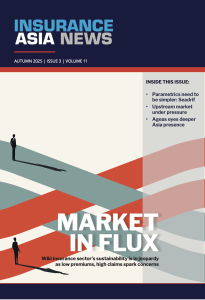SIRC: Aspen Re excited about opportunities in Asia, to grow portfolio in ‘measured way’
November 4 2025 by Aidan Gregory
Tay Boon Chuan, head of Singapore at Aspen, speaks to InsuranceAsia News about market conditions in APAC heading into 1.1 and where the firm’s growth strategy in the region.
1. What are the driving forces that are shaping 1.1 renewal discussions?
As we head into the all-important 1.1 renewal season, the year appears to be shaping up to be another strong one for reinsurers, barring unforeseen events in the final quarter.
While not quite as high as the last two years however, in the context of the past decade where reinsurers were mostly struggling to cover their cost of capital, the year was certainly no laggard.
This strong performance, along with the resulting inflow of reinsurer capacity and appetite for growth, will no doubt be a key talking point during year-end discussions.
In other words, to what extent will prices soften. Particularly, in short-tail classes like property cat, where recent-year performance tends to drive renewal outcome, however questionable the nexus might be.
Because we are loath to reduce the nuance and complexity of our client interaction to a simple number (minus 5% or 10%), it might be salutary to highlight a few things.
Firstly, the year has not been without its share of nat cat activity, and Asia is no exception. The tragic earthquake in Myanmar in March, and the resulting damage to property 1,000km away in Bangkok, is a reminder that few places are truly immune to seismic activity.
And while the current typhoon season thus far has not produced any outsized event, it is important to distinguish between longer-term trend and seasonal variability. The likely impact of climate change on lives and property has not abated.
All this is not mere headline-waving in an attempt to shore up renewal prices.
Rather, it is a recognition of the various structural improvements, forged in many territories during a hardening cycle, and a clarion call that we hold on to as many of these as we reasonably can, for the benefit of cedants and reinsurers alike.
Improvements such as better data capture for more accurate exposure monitoring and control, whether it be risk or cat. In this regard, ongoing attempts by Indonesian reinsurers to control risk accumulation via cession bordereaux should be lauded.
Also, improvements such as greater consistency in the retention/cession practice to obligatory treaties. Here, the shift in recent years in Korea towards fixed – rather than discretionary – QS % cession should be recognised, along with the improved transparency and reduced likelihood for post-event dispute.
Asia is a wide geographical expanse, and the reinsurance buying habits remain as varied as there are local nuances. But sound reinsurance structure, along with clear contractual language, should remain cornerstones, regardless of the size and needs of each cedant or territory.
The renewal prices will eventually find their equilibrium, based on prevailing supply and demand, whatever the cycle.
But retaining hard-fought structural improvements, whether it be sensible risk retention or cover adequacy and suitability, must surely remain longer-term imperatives for the collective benefit of the industry.
2. Are there any specific lines of business and countries in Asia Pacific where Aspen sees significant opportunities?
We remain excited about the growth opportunities in Asia and are looking to grow our portfolio in a measured way across the key lines of property, casualty, marine and agriculture.
Our target segment remains XoL Treaty. At the current stage of our corporate development, we feel XoL affords us the best balance between income growth, capacity use and expected margins.
We continue to engage with the wider market, including cedants who traditionally rely on pro rata capacities for business generation and growth, to seek cost-efficient and holistic solutions.
On property classes, XoL purchases tend to be driven by perceived exposure to natural perils and the likelihood of risks aggregation in a major event.
In that sense, Thailand could be an interesting territory this 1.1, with possible changes to reinsurance structure as the market comes to terms with its exposure to earthquake – and not just floods.
Otherwise, the risk landscape in the rest of Asia continues to evolve, whether it be increasing capacity requirements in fast growing segments like renewable energy, or changes to local tariff prompted by regulatory revisions. These developments often lead to changing reinsurance requirements.
At Aspen, we pride ourselves on our structuring and modelling capabilities, including multi-year solutions. We remain committed to work with our insurer and broking partners across Asia as they navigate the evolving risk landscape, whatever the pricing cycle.
-
QBE | Elevating customer experience, humanising claims: QBE Asia’s ‘Solutions in a Box’
Vastly improving turnaround times and personalising service delivery, QBE Asia’s award-winning, end-to-end bundled claims solutions is a game-changer for the insurance industry.
-
Beazley | What does cyber protection look like from day 1 to day 600 and beyond?
Cybersecurity is no longer just an IT concern, but a governance issue that belongs on the boardroom agenda.
-
Sedgwick | Preparing for the next storm
Insurance industry needs to recalibrate, invest in innovation and strengthen systems, talent and data practices.
-
Peak Re | From climate modelling to market opportunity: Forging a new clarity on Southeast Asia’s climate risk
Southeast Asia's protection gap: a crisis of clarity, not just capital

